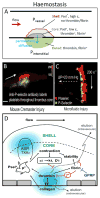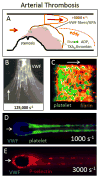Transport physics and biorheology in the setting of hemostasis and thrombosis
- PMID: 26848552
- PMCID: PMC4870125
- DOI: 10.1111/jth.13280
Transport physics and biorheology in the setting of hemostasis and thrombosis
Abstract
The biophysics of blood flow can dictate the function of molecules and cells in the vasculature with consequent effects on hemostasis, thrombosis, embolism, and fibrinolysis. Flow and transport dynamics are distinct for (i) hemostasis vs. thrombosis and (ii) venous vs. arterial episodes. Intraclot transport changes dramatically the moment hemostasis is achieved or the moment a thrombus becomes fully occlusive. With platelet concentrations that are 50- to 200-fold greater than platelet-rich plasma, clots formed under flow have a different composition and structure compared with blood clotted statically in a tube. The platelet-rich, core/shell architecture is a prominent feature of self-limiting hemostatic clots formed under flow. Importantly, a critical threshold concentration of surface tissue factor is required for fibrin generation under flow. Once initiated by wall-derived tissue factor, thrombin generation and its spatial propagation within a clot can be modulated by γ'-fibrinogen incorporated into fibrin, engageability of activated factor (FIXa)/activated FVIIIa tenase within the clot, platelet-derived polyphosphate, transclot permeation, and reduction of porosity via platelet retraction. Fibrin imparts tremendous strength to a thrombus to resist embolism up to wall shear stresses of 2400 dyne cm(-2) . Extreme flows, as found in severe vessel stenosis or in mechanical assist devices, can cause von Willebrand factor self-association into massive fibers along with shear-induced platelet activation. Pathological von Willebrand factor fibers are A Disintegrin And Metalloprotease with ThromboSpondin-1 domain 13 resistant but are a substrate for fibrin generation due to FXIIa capture. Recently, microfluidic technologies have enhanced the ability to interrogate blood in the context of stenotic flows, acquired von Willebrand disease, hemophilia, traumatic bleeding, and drug action.
Keywords: fibrin; hemodynamics; platelet; shear stress; thrombin; von Willebrand factor.
© 2016 International Society on Thrombosis and Haemostasis.
Conflict of interest statement
L. F. Brass reports grants from The NIH during the conduct of the study as well as personal fees from Merck Pharmaceuticals and Janssen Pharmaceuticals outside the submitted work.
S. L. Diamond has nothing to declare.
Figures


Similar articles
-
Flow and delta-P dictate where thrombin, fibrin, and von Willebrand Factor will be found.Thromb Res. 2016 May;141 Suppl 2:S22-4. doi: 10.1016/S0049-3848(16)30357-7. Thromb Res. 2016. PMID: 27207416
-
Fibrin, γ'-fibrinogen, and transclot pressure gradient control hemostatic clot growth during human blood flow over a collagen/tissue factor wound.Arterioscler Thromb Vasc Biol. 2015 Mar;35(3):645-54. doi: 10.1161/ATVBAHA.114.305054. Epub 2015 Jan 22. Arterioscler Thromb Vasc Biol. 2015. PMID: 25614284 Free PMC article.
-
Thrombus growth and embolism on tissue factor-bearing collagen surfaces under flow: role of thrombin with and without fibrin.Arterioscler Thromb Vasc Biol. 2012 Jun;32(6):1466-76. doi: 10.1161/ATVBAHA.112.249789. Epub 2012 Apr 19. Arterioscler Thromb Vasc Biol. 2012. PMID: 22516070 Free PMC article.
-
The hemostatic system.Curr Med Chem. 2004 Sep;11(17):2245-60. doi: 10.2174/0929867043364603. Curr Med Chem. 2004. PMID: 15379710 Review.
-
Role of von Willebrand factor in platelet thrombus formation.Ann Med. 2000 Dec;32 Suppl 1:2-9. Ann Med. 2000. PMID: 11209976 Review.
Cited by
-
A multiscale model for multiple platelet aggregation in shear flow.Biomech Model Mechanobiol. 2021 Jun;20(3):1013-1030. doi: 10.1007/s10237-021-01428-6. Epub 2021 Mar 29. Biomech Model Mechanobiol. 2021. PMID: 33782796 Free PMC article.
-
Fibrin clot properties and thrombus composition in cirrhosis.Res Pract Thromb Haemost. 2023 Jan 20;7(1):100055. doi: 10.1016/j.rpth.2023.100055. eCollection 2023 Jan. Res Pract Thromb Haemost. 2023. PMID: 36798901 Free PMC article.
-
Platelet activation via dynamic conformational changes of von Willebrand factor under shear.PLoS One. 2020 Jun 11;15(6):e0234501. doi: 10.1371/journal.pone.0234501. eCollection 2020. PLoS One. 2020. PMID: 32525962 Free PMC article.
-
NIH workshop report on the trans-agency blood-brain interface workshop 2016: exploring key challenges and opportunities associated with the blood, brain and their interface.Fluids Barriers CNS. 2017 May 1;14(1):12. doi: 10.1186/s12987-017-0061-6. Fluids Barriers CNS. 2017. PMID: 28457227 Free PMC article. Review.
-
Hemodynamic force triggers rapid NETosis within sterile thrombotic occlusions.J Thromb Haemost. 2018 Feb;16(2):316-329. doi: 10.1111/jth.13907. Epub 2018 Jan 12. J Thromb Haemost. 2018. PMID: 29156107 Free PMC article.
References
-
- Goldsmith HL, Turitto VT. Rheological aspects of thrombosis and haemostasis: basic principles and applications. ICTH-Report--Subcommittee on Rheology of the International Committee on Thrombosis and Haemostasis. Thromb Haemost. 1986;55:415–35. - PubMed
-
- Kefayati S, Holdsworth DW, Poepping TL. Turbulence intensity measurements using particle image velocimetry in diseased carotid artery models: Effect of stenosis severity, plaque eccentricity, and ulceration. J Biomech. 2014;47:253–63. - PubMed
-
- Sivanesan S, How TV, Black RA, Bakran A. Flow patterns in the radiocephalic arteriovenous fistula: an in vitro study. J Biomech. 1999;32:915–25. - PubMed
Publication types
MeSH terms
Substances
Grants and funding
LinkOut - more resources
Full Text Sources
Other Literature Sources
Medical

